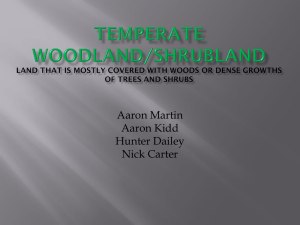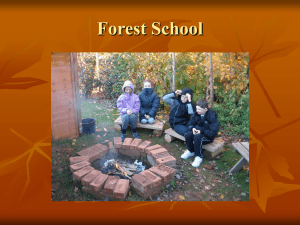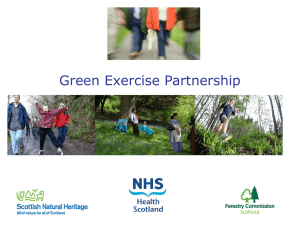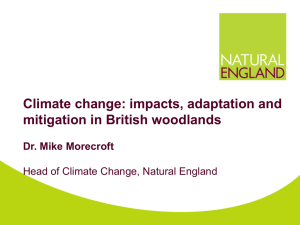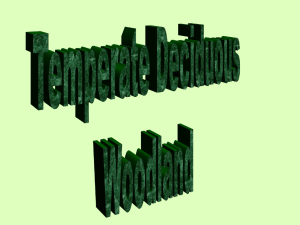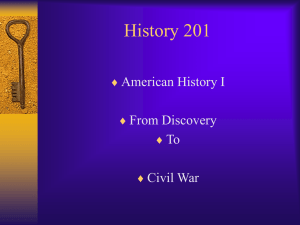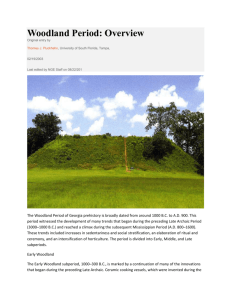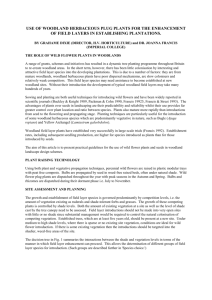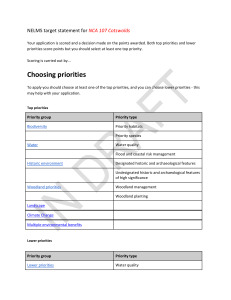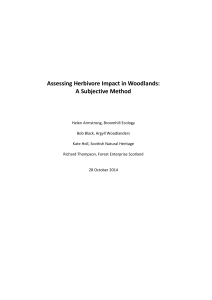Presentation - Farm Woodland Forum
advertisement
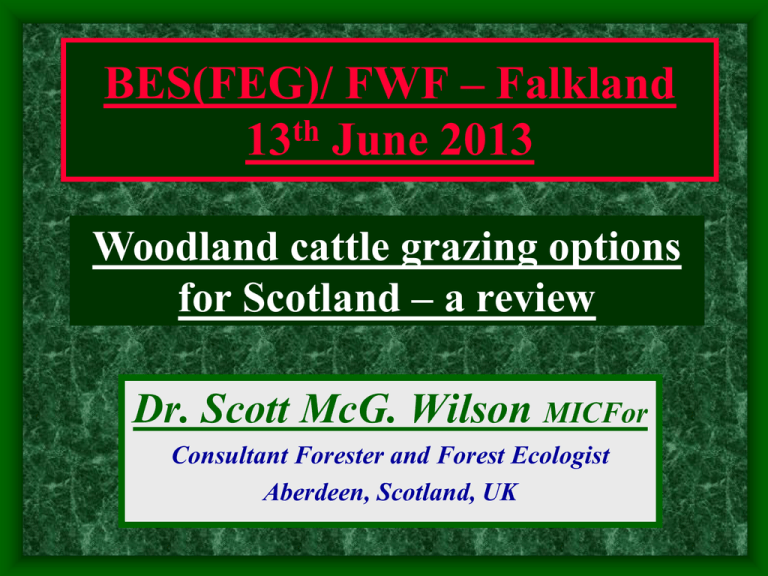
BES(FEG)/ FWF – Falkland 13th June 2013 Woodland cattle grazing options for Scotland – a review Dr. Scott McG. Wilson MICFor Consultant Forester and Forest Ecologist Aberdeen, Scotland, UK Aims of presentation Recent record. Objectives. Scenarios and examples. Benefits. Challenges. Incentives. Research and development needs. Dutch and English experiences. What distinguishes the Scottish situation? Recent record of adoption Historical wood-pasture awareness/ Vera. Over-grazed upland native woodlands. Agroforestry research for extensification. Livestock Exclusion Annual Premium. Weed growth v. natural tree regeneration. Woodland Grazing Toolbox (FC/SNH). SFGS S9 pilot scheme. Woodland grazing within the SRDP. Agroforestry as a component of WEAG. Objective sets for woodland grazing Scientific research and development. Vegetation/ habitat management (v. sheep). Native woodland conservation/ restoration. Enabling/ encouraging more afforestation. Historical landscape interpretation/ tourism. High quality/ heritage meat production. Farm forestry income/ diversification. Scenarios for woodland grazing Historical wood-pasture/ parkland habitats. Existing native woodlands. PAWS restn/ native woodland regeneration. Plantation forestry (existing/ mature). New woodland plantings (farm woodlots). Designed/ spaced-tree agroforestry trials. Key Scottish woodland grazing sites FCS Loch Katrine catchment. FCS Glen Garry, Loch Arkaig, Lochaber. JHI Glensaugh and Kirkton of Auchtertyre Bolfracks Estate, Perthshire Arisaig Estate, Lochaber Argyll, Perthshire and Galloway farms Key Scottish woodland cattle breeds Highland√ Luing √ Galloway √ Shorthorn (and crosses) √ Aberdeen Angus X Continental breeds X Benefits of woodland grazing Restructuring and diversification of vegn. Encouragement of native tree regeneration. Lower impacts than mechanical/ chemical. Additional income from marginal land. Contribution to national food security. Tourist attraction/ heritage interpretation. Challenges in woodland grazing Impacts on intolerant woodland vegetation. Risks of soil/ ground damage on wet sites. Intractable/ inaccessible upland site types. Additive impacts with high deer densities. Animal welfare/ nutritional balance. Poorly developed specialist meat markets. Seasonal pattern of heritage tourism. Distance/ weather-related economic factors. Lack of available/ tenacious rural labour. Incentives for woodland grazing Farming v. forestry dichotomy continues. Poorly developed agroforestry measures. High costs for some agroforestry options. Single Farm Payment issues/ eligibility [the >50 trees per hectare rule]. Farm Woodland Premium issues/ eligibility [the 15 years grant for 30 years exclusion]. Complexity of the RDP-based mechanisms [issues with agency costs, web-access etc.] Pillar 2 support – farm forestry options. Research and development needs Need much more extension support [revival of FWAG model in support of SAC etc.] Key research topics include sustainable levels of grazing under different woodland conditions and biodiversity impacts. Veterinary welfare and thermal balance. Economic and business development. Machinery rings and skills-pooling. Central locus for farm and forestry research. Dutch exchange – wood pasture lessons Non-intervention is non-viable in Europe? Not Serengeti, Masai Mara, Yellowstone! Not prehistoric European steppe either! Political reaction/ modern sensibilities. Difficult to really “prove” Vera’s science. Need to balance management objectives. Good models for conservation grazing. Best to ear-tag stock and sell organic meat! Valuable “eco-tourism draw” to projects Lowland England projects - features Not all projects involve woodland as the main grazed habitat – e.g. heaths, downs. Public are interested to see historic cattle. Many are interested to eat organic meat. Can combine a niche farming business with conservation grazing – along same lines as Millingerward or Drentsche Aa in Holland. Need to tell a story to customers about the grazing project, welfare and meat quality. Helps to have private money behind work. What makes Scotland different? Heritage of extensive upland wood-pasture. Record of over-grazing native woodlands. Large tracts of marginal upland ground. Extensive native habitat restoration work. Ambitious forestry expansion targets. Record of farm forestry/ shelter research. Distances/ remote terrain/ poor weather. Low population/ income density. Difficulties in sourcing local rural labour. Dutch/ English work – lessons for us? Need to put “front end” onto projects – e.g. farm shops, restaurants, droving to London, stalls at Borough Market, websites etc… Maybe a perception of Scottish projects as a wee bit too “science-based and specialist”? Challenge of lower population densities in Scotland, weaker premium/ organic sector, long “drive-to distance” for farm-shops etc. Over-dependence on public-sector funding, not enough business/ philanthropic support.

